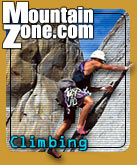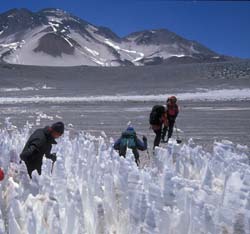
|
Acclimatizing in Atacama January 23, 2004
Editor's Note: Wally Berg and his Berg Adventures Team recently climbed Ojos del Salado in the Atacama Desert, the second highest peak in the western hemisphere, in preparation for their climb of Aconcagua. Below is a recount of their trip on Ojos as told by Berg via satellite phone. Click here to follow their current climb up Aconcagua. January 7, 2004 We're on a slope high above Santa Rosa Lake where we camped last night. Santa Rosa lake is just under 12,000 feet and maybe almost 3,600 meters and we climbed quite far above the lake on our acclimatization walk this morning. The terrain around me is vast and open and seems very pure and certainly beautiful. The colors are simple in the desert here, there's the brilliant white of the salt flats, there's also the brilliant green of Santa Rosa Lake adjacent to the salt flats, then there's the brown of the hills all around me and off in the distance you can see slivers of white glaciers, very small glaciers on the distant high peaks. The glaciers are quite small even though we are at high altitude in this area because it's an exceedingly dry environment. We are lucky enough again to have some representatives from the Mariner Energy Oceaneering group. I'm lucky enough to get to climb with these guys quite frequently now. On this trip we got Dave Huber, Richard Clark and Norb Gorman and as usual these guys work hard and they play hard. They work hard in their careers but they love their adventures and I always know they are going to show up for one of these climbs having prepared themselves to really push.
Paul Stempin will be making his second attempt on Aconcagua, having tried it a few years ago. He's looking to be in great shape and it's great to have him back around as well. Speaking of returns to summits, Donna Moll is back and you may recall from last year's Ojos dispatches that Donna was on that team as well and felt she hadn't trained quite as hard as she should have. She took this year to get herself prepared, had a minor setback; I would say a major setback actually with a torn ACL ligament in her knee. But she's bounced back great from that and is back for another attempt this year on Ojos as well as Aconcagua. Finally, we have one of my favorite father-son teams along. We got Dick and Tom Jessor again, those guys last climbed with me on Island Peak a few years ago, but they've been quite active in mountaineering since that time including a Boliva trip. I heard most about their really successful, lengthy, but successful ascent of Mount Rainier with Gary Porter from our Everest Climb last spring. It's always great to climb with these guys. Dick Jessor is 79 years old and not long ago he walked passed us as we were sitting on a rock and Norb asked me 'how can I learn to move as efficiently and as fast and well as that guy?' And I said well I think what Dick's got going for him is the muscle memory, the efficient movement of decades of tramping through the mountains and climbing. Climbing and being in the mountains around his home in Boulder Colorado is just one of his many passions. But it has paid off well and he says he's begun his 80th year and he looks great climbing these mountains. And it's a privilege to be back in the wilds with him again. January 9, 2004 Today is our day to walk the complete distance around Laguna Verde Lake. We are mid-way on that trip now and it's really been a very beautiful hike. It's one of my favorite walks in the world. There's red rock that looks for all the world like southeast Utah and there's borax or white salt flats. We just waded in an inlet, a pretty large stream that flows from glaciated mountains behind us to the west; the east side of the mountain has big glaciers and drain into this lake, although there is no outlet. The sky is cloudy today. We have regular weather here but I'm still wondering why the Atacama Desert is so dry. I used to know but I've forgotten and my curiosity is really up again about this. We are very close to the ocean here, we see clouds virtually every day and we also see very regularly afternoon winds pick up after the sun has heated the winds coming off the ocean. And the winds stay very high until the evening when it cools down again. So when we climb Ojos, and tomorrow when we climb Mula Muerto peak we'll be looking for an early start so we beat the wind. But, I still don't know why this weather does what it does, although I do find it fascinating and it produces beautiful landscapes. January 10, 2004 Today is our day to climb to 18,500 feet and I'm on my way down right now and it's gone remarkably well. The entire team has been strong. We all started right at 7 o'clock and I was with Paul Stempin at 17,800 feet when he and I decided that he would descend, just to kind of take care of an altitude headache. Remember, this is our first day this high and we're just going at it slow to let our bodies adapt. We walked back down to the high point for the rest of the group which was at 17,400 feet. I saw one figure heading our way and that was Norb. I knew it was Norb even though I couldn't recognize him because I knew Norb was going to push as far as he could until I told him it was time to go down. Norb has been really strong as he always is but he's got joints, knees that are bothering him and we need to take care of those. So we met up with Norb at 17,500 feet and turned back. But I'm proud to say we looked up the ridge and along with the Chilean guide Fernando, Gary, Daniel, Donna, Tom, Dave Huber and Richard were ascending to the very summit at 18,500 feet. So they made it all the way up. Donna stopped just short of the summit, I'm thinking she's taking care of her knee, but those guys did great. January 11, 2004 We are at Laguna Verde camp and life at 14,500 feet continues to make each of us aware that we are at altitude, but also we feel better every day. We are adapting, we are acclimatizing. Tomorrow we'll go up to 17,500 feet to what we call camp 1, as we get ready to actually climb Ojos on the 14th of January. A group of us today went back across on the other side of Laguna Verde, looking for Inca Ruins under the leadership of Max, who is on the guide staff as our resident naturalist and observer of the world. They had a great deal of success, not only having a great hike, but finding some Inca relics and ruins in this vast area that really has seen very little visiting over the century. It's amazing to see what ancient people did in this area, still laying in this dry climate where things are so well preserved. Then Grant, Gary and I went up to Reconnoiter to check out the route to camp 1. You may not know, but a four wheel drive exploring across the desert terrain here is a part of this trip. We checked out the route tomorrow for the vehicles as we'll be driving up towards Ojos, and it changed from last year the way I remember it, but it's going to be very doable and we got a good notion of what we'll be doing tomorrow as we drive up a lot higher and get prepared to climb Ojos. January 12, 2004 We took off doing shuttles in two crew cab 4-wheel drive pickups out across the sand flats with Ojos spread before us. We got closer and closer and we drove up to the shelter of a moraine, and we've got a beautiful camp established at 17,500 feet. We're going to prepare to attempt Ojos on Wednesday the 14th. January 15, 2004 It's late at night, just before midnight on the 15th, and we're in Copiapo, Chile. That's at about 800 meters (2,625 feet) above sea level. It's amazing for me because earlier today a few of us were in the crater on top of Ojos del Salado at 6,700 meters (21,983 feet). I've done a lot of wild things in the mountains, but I've never done such a big descent in one day. We drove back in the darkness, the last truck load of us. Grant drove most of the way. He stepped out once we got down out of the mountains, when we were coming into the last section of the drive into Copiapo, when he commented on how thick the air felt. Actually humid, even though it's still in the desert just a richness and a thickness to the air that we had missed at the high altitudes where we've been.
Now we're back in the city taking showers and washing off all of the dust that we lived in, in that wonderful wild area, the high desert of the Ojos region. It was all about acclimatization and getting ready for Aconcagua, enjoying that in its own right. I had several people make this comment, and I said to myself that was an excellent first half of the trip. The acclimatization that we have stored away under our belts, in our hearts and certainly physiologically, for climbing in the high mountains is going to pay off as we cross over into Argentina day after tomorrow, and get our permits and get ready to go to Aconcagua. -- Wally Berg
|
||||||||||||||||

